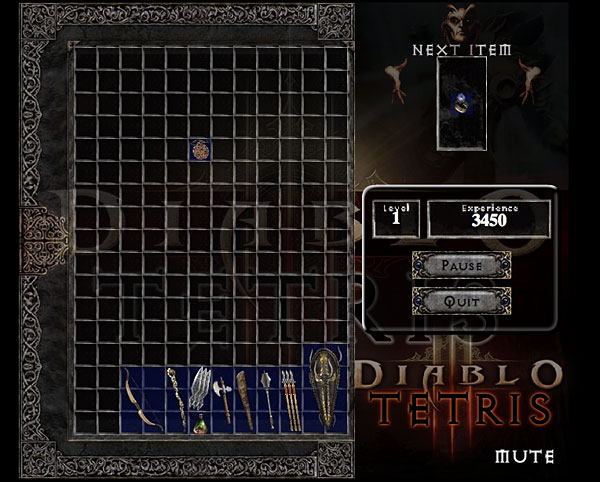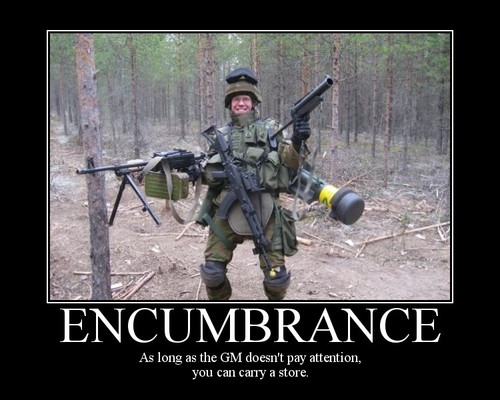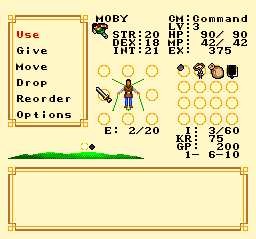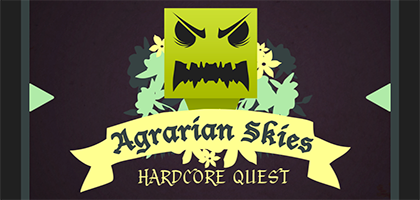- by Arthur "Arturis" Orneck
- Posted on February 10, 2012 @ 4:00 PST

(The following article was originally posted on MMOSite's Quest! Gaming Blog on January 1st, 2011. I have decided that I want to continue writing this column, so I am carrying over the original posts in-tact, bad spelling/grammar/assumptions and all, so that I can show where my thoughts are coming from prior to getting to where they are now - Arturis)
Game Theory: Inventing the Inventory
 If there is anything that practically every major RPG has in common, as well as plenty of games outside the RPG genre, it is the concept of an "inventory". Every world we explore seems to be brimming with an ever increasing amount of stuff, and it is the inventory system that allows us to take some of this stuff along with us. While the concept of carrying multiple items along with us on our adventures is often taken for granted by the players, there are quite a few important, game impacting decisions that go into designing an inventory system that is not only practical and efficient, but is also appropriate for the feel of the game world the designer is trying to convey. Once again, I ask you to take a moment with me to look a little deeper into the game mechanics we see every day, and think about the design decisions that drive them.
If there is anything that practically every major RPG has in common, as well as plenty of games outside the RPG genre, it is the concept of an "inventory". Every world we explore seems to be brimming with an ever increasing amount of stuff, and it is the inventory system that allows us to take some of this stuff along with us. While the concept of carrying multiple items along with us on our adventures is often taken for granted by the players, there are quite a few important, game impacting decisions that go into designing an inventory system that is not only practical and efficient, but is also appropriate for the feel of the game world the designer is trying to convey. Once again, I ask you to take a moment with me to look a little deeper into the game mechanics we see every day, and think about the design decisions that drive them.
Table Top Tabulations
The majority of the base concepts we find in modern RPGs have their roots in old school "Pen & Paper" Tabletop style role playing, and inventory is no exception. In fact, a large part of the character creation process in systems like Dungeons & Dragons involved the "purchase" of various items to stock up your characters inventory, tailored to that character's profession and personality. Rarely did my adventuring characters start their journey without a pack full of basic supplies: Flint and tinder, torches, silken rope, rations, and whatever other various sundries I felt would be useful to my character's adventuring life. Inventory, at that point, was simply a listing of items you were carrying, written out in a box or elsewhere on the crumpled piece of loose leaf paper that was acting as you character sheet. While some Dungeon Masters preferred to use the optional Encumbrance rules, which assigned weight values to each item in order to calculate penalties for when you were carrying too much, more often than not those rules were tossed to the side in favor of cutting down on math during game play. While text-based adventure games, MUDs and early graphical video games used similar "just list the items" type systems, it wasn't until the rise of PC gaming's favorite input device, the mouse, that we had our next evolutionary jump in inventory management.
A Tale of Two Grids
With the introduction of the mouse as a standardized component of the average personal computer, game developers started designing more visually oriented games. Soon, the Grid style of inventory management was born - each item in the game world would be represented by an icon, and these icons could then be be contained within a grid that represented your inventory space. Contrary to what we know from the real world, however, a single item takes up a single "slot" in this imaginary grid, no matter what the size or shape of the item in question is. Moving, buying, selling or destroying items became as simple as dragging them around the screen. The system was so simple and usable, that it became the standard way of dealing with inventory, and it still the most widely used form of inventory management in RPGs today, both MMO and single player alike.
 There is, however, an "offshoot" of this system, where items can take up the space of more than one grid slot. People often refer to this as "Diablo-style" Inventory, as it was made famous by Blizzard's hack'n'loot-centric Diablo franchise. In this system, small item such as a coin or gem will take up only 1 slot of your inventory grid, while a larger item, such as a sword, may take up three slots (in a 1x3 column). With this system, inventory management can then be a sort of mini puzzle game of its own, forcing the player to juggle around the positions of items in order to cram as much items in without wasting space or having to leave items behind.
There is, however, an "offshoot" of this system, where items can take up the space of more than one grid slot. People often refer to this as "Diablo-style" Inventory, as it was made famous by Blizzard's hack'n'loot-centric Diablo franchise. In this system, small item such as a coin or gem will take up only 1 slot of your inventory grid, while a larger item, such as a sword, may take up three slots (in a 1x3 column). With this system, inventory management can then be a sort of mini puzzle game of its own, forcing the player to juggle around the positions of items in order to cram as much items in without wasting space or having to leave items behind.
From a game design point of view, both grids have their pros and cons. A standard grid is great for ease of use (and ease of programming) because you don't have to worry about how much inventory space an item will take up. On the other hand, you sacrifice a sense of realism - Why is that 8 foot tall polearm taking up just as much space in my inventory as that inch-in-diameter Gnoll eye quest item? - and a sacrifice of realism is always a hit to the all important immersion factor (as we discussed in the last Game Theory post). A Diablo-style grid takes the size of items into account, but do you really want your player juggling their inventory around in the middle of frantic combat, or risk the chance of leaving a powerful magic item (or worse still, an important quest item) behind?
Beyond the choice of grids, other inventory design decisions have to be made. How much grid space will you give to players? Will it be expandable by additional bags/storage solutions, or is that all the player gets for the entire game? Can similar items stack together inside one cell, and if so, how many can be in a stack? What does double clicking an icon do?
The Weight of the Virtual World
 Which weighs more in a video game, an elephant or a feather? The answer is neither, as neither exist as anything more then stored information. Never the less, we as players like to see weight portrayed in video games, because it helps us better associate the virtual world with the real world.
Which weighs more in a video game, an elephant or a feather? The answer is neither, as neither exist as anything more then stored information. Never the less, we as players like to see weight portrayed in video games, because it helps us better associate the virtual world with the real world.
To this extent, developers have to come up with creative ways to give the illusion of objects having substantial, yet appropriate, weight to them. Often, animations for swinging a heavier weapon will be exaggerated to help get the sense of weight across to the viewer - the attack may be slower, as it may take more effort to “start” the swing or perhaps a bit more follow through as the character model compensates for the inertia after the swing.
Beyond just visuals, however, certain games will also have an Encumbrance system. The two basic principles that often govern an Encumbrance system are as follows:
Every item has an associated weight value - often an integer that represents the items weight in whatever the established game world’s measuring system happens to be: pounds, grams, stones, etc...
The player has a maximum amount of weight he/she can carry, often modified by physical statistics, before receiving some in-game penalty.
Programmatically, this is very simple system to implement. Add up the weight values of all items that the character is carrying or wearing, and compare that with the maximum amount of weight they can carry at one time. If the total weight is greater then the allowable weight, inflict a penalty, the most common of which is impaired movement.
There was a long running practical joke in the original EverQuest, where sinister higher level players would chose people just starting their characters off, and offer them a ton of money in coppers. Most new players didnt know about the Encumbrance rules, and would gladly accept the free cash. However, in the EverQuest engine, 1 copper was the weight of one “stone”, their standard for weight measurement. The trick of the scam was this: A higher level player has a higher Strength rating, and thus could carry a lot more than a lower level player could before becoming encumbered. Receiving such large amounts of copper at once would immediately exceed the new player’s allowable weight limit, rooting the newly rich yet gullible sod firmly where he stood. The only way to for that player to be able to move again was to give away or drop as much copper as it took to get back under their weight limit, a fact that more often then not the new player wouldn’t know, leading to a lot of mewling for help in the zone-wide chat channel.
Playing with Paper Dolls
 Back to the topic at hand: You have a backpack-grid completely stuffed to the brim with various items (most likely of various weights): Armor, weapons, potions, random quest related nick-knacks - but what do you do with all of it? Along the same time the Drag And Drop inventory Grid came into being, so did the concept of the "paper doll" Equipment system. In a paper doll system, somewhere in the inventory screen will be a representation of your character, with additional inventory grid-like slots positioned around it. Each slot is labeled and/or is pointing to specific equipment locations on the body - chest, legs, hands, feet, head, etc etc. Dragging items from your inventory over to the paper doll will equip them, dragging them back will, in turn, un-equip them.
Back to the topic at hand: You have a backpack-grid completely stuffed to the brim with various items (most likely of various weights): Armor, weapons, potions, random quest related nick-knacks - but what do you do with all of it? Along the same time the Drag And Drop inventory Grid came into being, so did the concept of the "paper doll" Equipment system. In a paper doll system, somewhere in the inventory screen will be a representation of your character, with additional inventory grid-like slots positioned around it. Each slot is labeled and/or is pointing to specific equipment locations on the body - chest, legs, hands, feet, head, etc etc. Dragging items from your inventory over to the paper doll will equip them, dragging them back will, in turn, un-equip them.
While this system is intuitive and streamlined from a player's point of view, just like the inventory grid there are a ton of design decisions that go into this part of the process. What equipment slots will be provided? Will you allow equipping weapons in the off hand, or will it just be for shields? Which equipped items will actually show on the player model, and which will have no effect on it? Can items be swapped during combat?
Chose the Form of your Destructor
While there are technically no right or wrong answers to these design questions (or the ones I will be asking in future articles), some solutions may be more appropriate to the feel of the game you are trying to create. Often, games that stress action over strategy will have a more simplified inventory system, so that finding/equipping an item in your inventory doesn't get in the way of using said item. Games that have slower, more methodical and more strategic game play often have more elaborate inventory systems, as they want you to take your time in choosing the appropriate equipment for each task. Whatever side of the spectrum you are aiming at with your design, or even if you are aiming at somewhere in the middle, it is important to put some serious thought into every aspect of the game, including the inventory system. More often than not, it is these little design decisions that can make or break a game.
I've never really thought much about how we carry stuff around in games, until I read this article.
I find that there is rarely an inventory system that I actually enjoy, probably the closest would be either Deus Ex or RE4, which is like the "Diablo system" but even then, carrying ammo for each gun makes it unnecessarily difficult to carry more than a few weapons.














